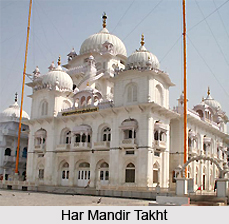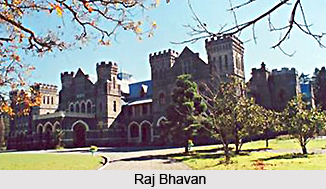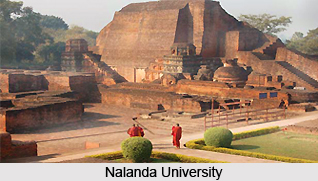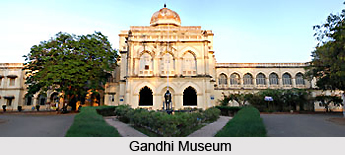 Monuments in Patna include museums, archaeological sites, mosques and a number of other historical monuments. Patna, the ancient Pataliputra, is the capital of the state of Bihar. Located on the southern banks of the River Ganges, it is in close proximity to the meeting point of River Gandak, 544 kilometres away from Kolkata on the main line of the Eastern Railways. The city of Patna is very extensive, running from east to west parallel to the river. It is one of the most ancient Indian cities, the capital of the Maurya dynasty of the 4th and the 3rd centuries BC. The excavated remains of the original settlement of Pataliputra are located in between Dinapore and Patna.
Monuments in Patna include museums, archaeological sites, mosques and a number of other historical monuments. Patna, the ancient Pataliputra, is the capital of the state of Bihar. Located on the southern banks of the River Ganges, it is in close proximity to the meeting point of River Gandak, 544 kilometres away from Kolkata on the main line of the Eastern Railways. The city of Patna is very extensive, running from east to west parallel to the river. It is one of the most ancient Indian cities, the capital of the Maurya dynasty of the 4th and the 3rd centuries BC. The excavated remains of the original settlement of Pataliputra are located in between Dinapore and Patna.
After lapsing into obscurity for centuries the city revived under the rule of Sher Shah Suri, who constructed the fort in the year 1541. Under the Mughals it was a provincial capital until the year 1765. With the creation of Orissa and Bihar in the year 1912, Patna was restored as the capital city of Bihar. The new Patna is situated at a distance of two miles to the west of Bankipore and is the headquarters of the government of Bihar. The layout of the new city, which is virtually contemporaneous with New Delhi, is a typical exercise in Imperial town planning, with long, wide avenues flanked by government buildings and vistas terminating in impressive facades. Architecturally, it is an Indian rendition of the style of classical architecture popularized by the Wembley Exhibition of 1923, executed in brick and plaster rather than stone. The new capital was laid out by the architect J. F. Munnings, a partner in Power, Adam & Munnings of Sydney, Australia. The main axis is King George`s Avenue, which links the Secretariat with Government House in the grand manner, over one mile long, and 200 ft wide and lined with trees. The secondary roads are 150 ft in width.
 Government House or Raj Bhavan was designed by Munnings. It stands at the western end of the capital, a three-storey building on a north-south axis, located in a large landscaped garden of over 110 acres. Internally, the ground floor is given over to reception rooms, including the main dining and drawing rooms. The Durbar Hall and ballroom are located to the west side of the main block and rise through two storeys, overlooked by the colonnaded balconies of the first floor. It is the official residence of the Governor of Bihar. The Secretariat is situated at the end of King George`s Avenue, a huge building with a prominent clock tower, originally 178 ft high although the tower partly collapsed following the earthquake in the year 1934. In the time of the Second World War the balconies and corridors were converted into improvised rooms and this has badly impaired the character of the building. A fine view can be obtained from the balcony at the top of the clock tower.
Government House or Raj Bhavan was designed by Munnings. It stands at the western end of the capital, a three-storey building on a north-south axis, located in a large landscaped garden of over 110 acres. Internally, the ground floor is given over to reception rooms, including the main dining and drawing rooms. The Durbar Hall and ballroom are located to the west side of the main block and rise through two storeys, overlooked by the colonnaded balconies of the first floor. It is the official residence of the Governor of Bihar. The Secretariat is situated at the end of King George`s Avenue, a huge building with a prominent clock tower, originally 178 ft high although the tower partly collapsed following the earthquake in the year 1934. In the time of the Second World War the balconies and corridors were converted into improvised rooms and this has badly impaired the character of the building. A fine view can be obtained from the balcony at the top of the clock tower.
The Council Chambers, designed in Free Renaissance style by A. N. Millwood, are located to the east of the Secretariat. The chambers are 60 feet long and 50 feet wide and extend through both floors, with an upper gallery for the public and press. At a distance of about two hundred and twenty eight meters to the east of the eastern gate of the Secretariat is the Martyrs` Memorial, bronze statuary in a heroic manner remembering the seven nationalist students who died on the 9th of August 1942, after being shot by police while they were trying to hoist the national flag on the Secretariat. Between the Secretariat and the railway station is Hardinge Park, which commemorates the visit to Patna in the year 1913 of the Viceroy Lord Hardinge of Penshurst, architect of the province of Orissa and Bihar. A bronze statue of Hardinge, by Herbert Hampton, which once stood in the park, a bust of Lady Hardinge and two plates depicting justice between men and sympathy to suffering humanity, were moved to the Patna Museum in the year 1967. Away from Bayley Road is the High Court, which is a fine exercise in civic Baroque closely-modelled on the High Court at Allahabad by Frank Lishman. Internally, there is a fine marble staircase behind the pedimented entrance portico.
 On the Patna-Dinapore road is the Sadakat Ashram, which guided the freedom movement in Bihar. Mahatma Gandhi, Dr. Rajendra Prasad and Maulana Mazarul Haque were frequent visitors to this ashram. The Patna Museum, on Buddha Marg, is an elegant range in Indo-Saracenic architecture in India with square corner towers capped by domes. It has a fine collection of stone sculpture, bronzes, prehistoric implements, terracotta figures, copper plates, pottery and other ancient artefacts.
On the Patna-Dinapore road is the Sadakat Ashram, which guided the freedom movement in Bihar. Mahatma Gandhi, Dr. Rajendra Prasad and Maulana Mazarul Haque were frequent visitors to this ashram. The Patna Museum, on Buddha Marg, is an elegant range in Indo-Saracenic architecture in India with square corner towers capped by domes. It has a fine collection of stone sculpture, bronzes, prehistoric implements, terracotta figures, copper plates, pottery and other ancient artefacts.
The central sector of Patna lies to east of the Buddha Marg on the edge of Patna University campus. The road from the railway station to the Maidan passes a number of interesting houses. Opposite and beyond the jail is an early nineteenth century bungalow. Further on is a fine Art Deco house of the 1920s. The Gandhi Maidan covers about an area of about 64 acres and is well laid out with trees and footpaths. To the north-east is the Anglican Christ Church. The Gola or Golghar is one of the most extraordinary buildings in India which is worth seeing. It stands by a small park on the west edge of the Maidan and resembles a huge beehive towering over the trees. It was constructed by Colonel John Garstin in the year 1786, as a famine-relief measure but was never used. Over 90 ft high, there is an external staircase to the top, where the grain was unloaded. The flat platforms adjoining the stairs were resting places. It has a theoretical capacity of 137,000 tons and a spectacular internal echo. 137 meter round at the base and about 33 meter in diameter, it is a local landmark. The view from the top across the Ganga River is stunning. It is alleged that Sir Jang Bahadur of Nepal once rode a pony to the summit. There is the plaque commemorating Garstin at the base. The Randfurlie Knox Monument lies close to the river in the compound of the Judge`s Court. This tall obelisk recalls the gallant Knox, who marched from Burdwan to relieve the siege of Patna by Shah Alam in the year 1760.
 At a distance of about eight hundred meters to the east is the Khuda Bakhsh Oriental Public Library, established in the year 1900 by Maulavi Khuda Bakhsh Khan Bahadur. It is a renowned repository of ancient and rare Arabic and Persian manuscripts. Among the collection are the only surviving volumes from the sack of the university at Cordoba in Spain. Situated in close proximity to the Library is the Patna College. The administrative block, close to the river, is a fine Dutch colonial building of the 18th century. The lower range has a Doric order, the upper Corinthian, and although altered and extended in the 19th century, it is a fine example of the period. The elegant Lecture Theatre was erected in the year 1927. TO the north-western portion of the Maidan is the Gandhi Museum. On the river front is Gandhighat, a pleasant garden and pavilion commemorating the Mahatma, whose ashes were dispersed at the confluence of the Ganges and Gandak on 30th January 1948. Close by is the Bihar College of Engineering, in a simple Indo-Saracenic style. Other buildings near the river bank include the Collectorate, National College, Prince of Wales Medical College and Hospital, University Senate House and Law College.
At a distance of about eight hundred meters to the east is the Khuda Bakhsh Oriental Public Library, established in the year 1900 by Maulavi Khuda Bakhsh Khan Bahadur. It is a renowned repository of ancient and rare Arabic and Persian manuscripts. Among the collection are the only surviving volumes from the sack of the university at Cordoba in Spain. Situated in close proximity to the Library is the Patna College. The administrative block, close to the river, is a fine Dutch colonial building of the 18th century. The lower range has a Doric order, the upper Corinthian, and although altered and extended in the 19th century, it is a fine example of the period. The elegant Lecture Theatre was erected in the year 1927. TO the north-western portion of the Maidan is the Gandhi Museum. On the river front is Gandhighat, a pleasant garden and pavilion commemorating the Mahatma, whose ashes were dispersed at the confluence of the Ganges and Gandak on 30th January 1948. Close by is the Bihar College of Engineering, in a simple Indo-Saracenic style. Other buildings near the river bank include the Collectorate, National College, Prince of Wales Medical College and Hospital, University Senate House and Law College.
Patna`s eastern sector extends from Gandhighat to the eastern limit of the city. Three miles to the east of the Patna College is Gulzarbagh, the old opium quarter, which traded until 1911, when it was closed by the government. The old buildings are now occupied by the Government Press but can be recognized by the high wall around the compound on the river bank. The site is that of the original English factory. The Duchess of Teck Hospital is situated on higher ground about one kilometre to the west. Towards the east of Gulzarbagh is the west gate of Patna city. Near the Chowk is the Har Mandir Takht, one of the Sikh temples in India and it also marks the birthplace of the tenth Guru, Guru Gobind Singh. It is one of the four holy temples of the Sikhs. Jains and Hindu shrines of note are also there which include the Moti Brahma, a contemporary of Ashoka, who lies buried at the Brahmasthan.
 At a distance of about eight hundred meters to the west of the Har Mandir at Padri-Ki-Haveli is the Roman Catholic Cathedral of the Blessed Virgin Mary. Erected between 1772 and 1779, it was probably designed by Edward Tiretta and was built by Capuchin Father Joseph of Rovato. It is a distinguished church with a lofty dome and a fine pedimented Ionic portico. Internally, the order is Corinthian. The bell was donated in the year 1782 by Bahadur Shah, son of the Maharaja of Nepal. Immediately opposite to the Cathedral is the Old Cemetery. Located in close proximity to the City Dispensary is an obelisk on the site of the well where the bodies of sixty English captives were thrown by Samru (Walter Reinhardt) on the orders of Mir Qasim on the 6th and 11th of October in the year 1763. In November the massacre was avenged by Major Adams, who stormed the city. The nearby Mangal Talao Tank was constructed to commemorate Mr. Ross Mangles, VC, the local Collector and one of the heroes of the siege of the house at Arrah in the year 1857.
At a distance of about eight hundred meters to the west of the Har Mandir at Padri-Ki-Haveli is the Roman Catholic Cathedral of the Blessed Virgin Mary. Erected between 1772 and 1779, it was probably designed by Edward Tiretta and was built by Capuchin Father Joseph of Rovato. It is a distinguished church with a lofty dome and a fine pedimented Ionic portico. Internally, the order is Corinthian. The bell was donated in the year 1782 by Bahadur Shah, son of the Maharaja of Nepal. Immediately opposite to the Cathedral is the Old Cemetery. Located in close proximity to the City Dispensary is an obelisk on the site of the well where the bodies of sixty English captives were thrown by Samru (Walter Reinhardt) on the orders of Mir Qasim on the 6th and 11th of October in the year 1763. In November the massacre was avenged by Major Adams, who stormed the city. The nearby Mangal Talao Tank was constructed to commemorate Mr. Ross Mangles, VC, the local Collector and one of the heroes of the siege of the house at Arrah in the year 1857.
Apart from these; there are three Muslim buildings of note in Patna. Sher Shah`s Mosque in Haziganj was constructed between 1541 and 1545 in a bold Afghan style. The citadel was in the north-east corner. The Pathar ki Masjid, a rather inelegant stone mosque in Sultanganj, was erected in the year 1626 by Mahabat Khan. Mir Afjal`s Mosque, which is located behind the Bihar College of Engineering, is a little gem where the Emperor Farrukhsiyar worshipped.



















